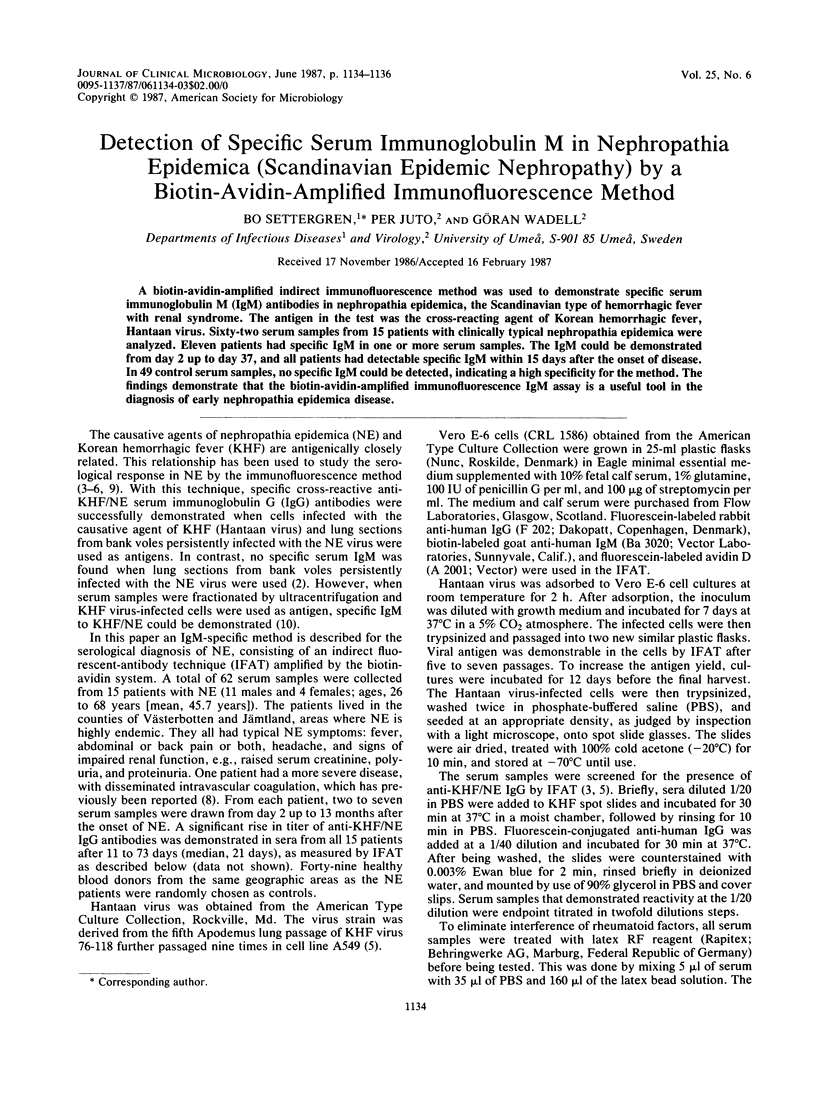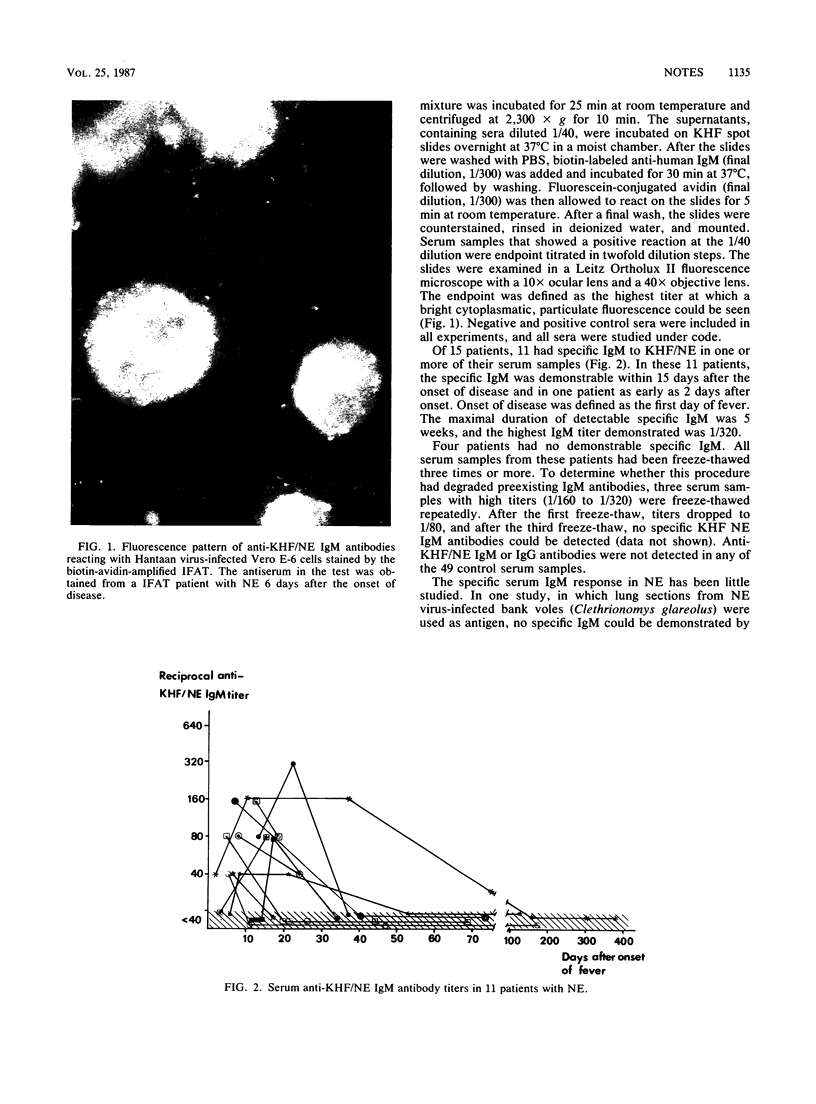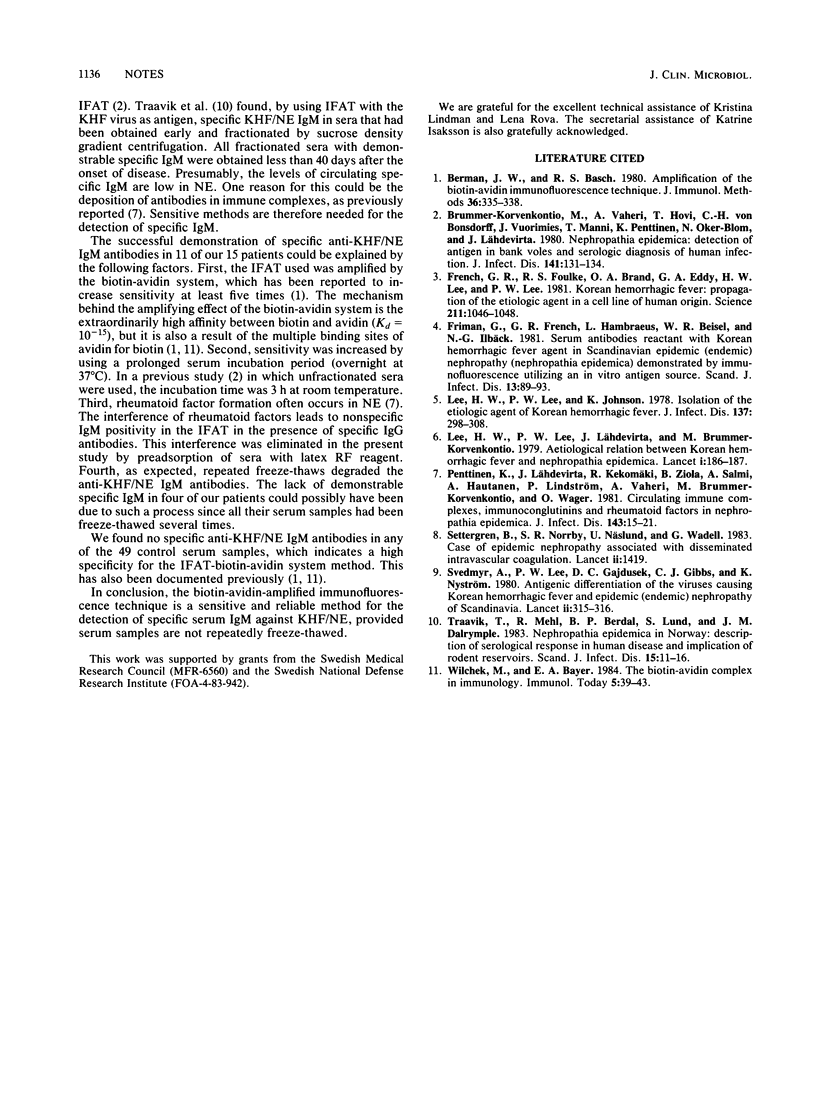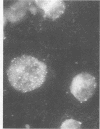Abstract
A biotin-avidin-amplified indirect immunofluorescence method was used to demonstrate specific serum immunoglobulin M (IgM) antibodies in nephropathia epidemica, the Scandinavian type of hemorrhagic fever with renal syndrome. The antigen in the test was the cross-reacting agent of Korean hemorrhagic fever, Hantaan virus. Sixty-two serum samples from 15 patients with clinically typical nephropathia epidemica were analyzed. Eleven patients had specific IgM in one or more serum samples. The IgM could be demonstrated from day 2 up to day 37, and all patients had detectable specific IgM within 15 days after the onset of disease. In 49 control serum samples, no specific IgM could be detected, indicating a high specificity for the method. The findings demonstrate that the biotin-avidin-amplified immunofluorescence IgM assay is a useful tool in the diagnosis of early nephropathia epidemica disease.
Full text
PDF


Images in this article
Selected References
These references are in PubMed. This may not be the complete list of references from this article.
- Berman J. W., Basch R. S. Amplification of the biotin-avidin immunmofluorescence technique. J Immunol Methods. 1980;36(3-4):335–338. doi: 10.1016/0022-1759(80)90138-6. [DOI] [PubMed] [Google Scholar]
- Brummer-Korvenkontio M., Vaheri A., Hovi T., von Bonsdorff C. H., Vuorimies J., Manni T., Penttinen K., Oker-Blom N., Lähdevirta J. Nephropathia epidemica: detection of antigen in bank voles and serologic diagnosis of human infection. J Infect Dis. 1980 Feb;141(2):131–134. doi: 10.1093/infdis/141.2.131. [DOI] [PubMed] [Google Scholar]
- French G. R., Foulke R. S., Brand O. A., Eddy G. A., Lee H. W., Lee P. W. Korean hemorrhagic fever: propagation of the etiologic agent in a cell line of human origin. Science. 1981 Mar 6;211(4486):1046–1048. doi: 10.1126/science.6110243. [DOI] [PubMed] [Google Scholar]
- Friman G., French G. R., Hambraeus L., Beisel W. R., Ilbäck N. G. Serum antibodies reactant with Korean haemorrhagic fever agent in Scandinavian epidemic (endemic) nephropathy (nephropathia epidemica) demonstrated by immunofluorescence utilizing an in vitro antigen source. Scand J Infect Dis. 1981;13(2):89–93. doi: 10.3109/inf.1981.13.issue-2.02. [DOI] [PubMed] [Google Scholar]
- Lee H. W., Lee P. W., Johnson K. M. Isolation of the etiologic agent of Korean Hemorrhagic fever. J Infect Dis. 1978 Mar;137(3):298–308. doi: 10.1093/infdis/137.3.298. [DOI] [PubMed] [Google Scholar]
- Lee H. W., Lee P. W., Lähdevirta J., Brummer-Korventkontio M. Aetiological relation between Korean haemorrhagic fever and nephropathia epidemica. Lancet. 1979 Jan 27;1(8109):186–187. [PubMed] [Google Scholar]
- Penttinen K., Lähdevirta J., Kekomäki R., Ziola B., Salmi A., Hautanen A., Lindström P., Vaheri A., Brummer-Korvenkontio M., Wager O. Circulating immune complexes, immunoconglutinins, and rheumatoid factors in nephropathia epidemica. J Infect Dis. 1981 Jan;143(1):15–21. doi: 10.1093/infdis/143.1.15. [DOI] [PubMed] [Google Scholar]
- Settergren B., Norrby R., Näslund U., Wadell G. Case of epidemic nephropathy associated with disseminated intravascular coagulation. Lancet. 1983 Dec 17;2(8364):1419–1419. doi: 10.1016/s0140-6736(83)90944-3. [DOI] [PubMed] [Google Scholar]
- Svedmyr A., Lee P. W., Gajdusek D. C., Gibbs C. J., Jr, Nyström K. Antigenic differentiation of the viruses causing Korean haemorrhagic fever and epidemic (endemic) nephropathy of Scandinavia. Lancet. 1980 Aug 9;2(8189):315–316. doi: 10.1016/s0140-6736(80)90260-3. [DOI] [PubMed] [Google Scholar]
- Traavik T., Mehl R., Berdal B. P., Lund S., Dalrymple J. M. Nephropathia epidemica in Norway: description of serological response in human disease and implication of rodent reservoirs. Scand J Infect Dis. 1983;15(1):11–16. doi: 10.3109/inf.1983.15.issue-1.03. [DOI] [PubMed] [Google Scholar]



